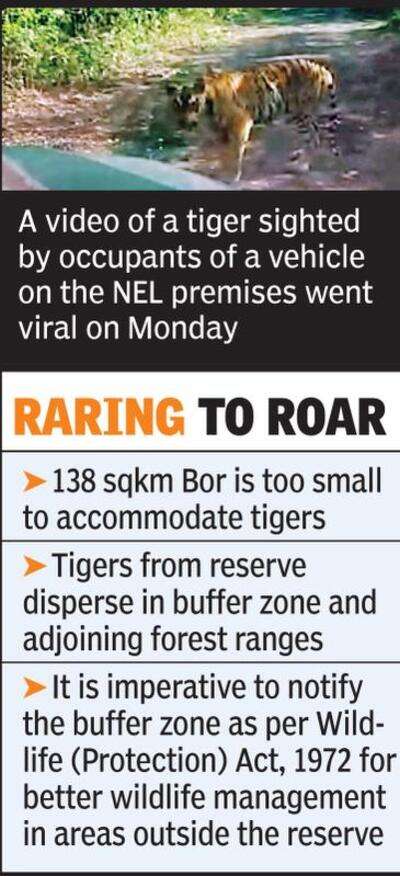
Nagpur: With tigers struggling for space, a Bor Tiger Reserve sub-adult has made a defunct explosives factory in Hingni its home. The cub is said to be one of the three offsprings of the park’s dominant tigress Katrina.
With an area of 138sqkm, Bor is the smallest tiger reserve in the country. It is a tiger source with scientific reports of sub-adult cubs, especially males who need a big area, dispersing in search of new territories.
On Monday, a video of a tiger sighted by a vehicle in the defunct Noble Explochem Limited (NEL) premises on the outskirts of Hingni went viral reminding one of the May 2009 episode in which a tigress had delivered 4 cubs in another defunct Maharashtra Explosives Limited (MEL) factory near Kelzar.
The Noble factory is hardly 5km from the park’s boundary and it is possible the sub-adult tiger must have ventured out in search of a new territory.
Generally, a tigress deserts her cubs until they are 18 months when they are capable of hunting on their own, but Bor’s Katrina has a history of deserting her litter as early as 12-15 months.
According to the security guards, they regularly sight two tigers and a leopardess with two cubs moving in the sprawling 1,200-hectare area, which has virtually turned into a dense forest. The area has natural water holes and a wild prey base, too, besides cattle and dogs.
However, Wardha deputy conservator of forest (DyCF) Sunil Sharma confirmed there is movement of one tiger from the neighbouring Bor in the factory area. “We first saw the big cat in May. There is always wildlife movement in the factory area.”
Hingni Range Forest Officer (RFO) RC Vaidya said, “In the camera trap, only one image of the tiger has been captured. Reports of the leopard family are also true. We will intensify patrolling and plan to hold meetings with locals to make them aware of the possible conflict. Display boards will also be put up. Forest guards are in regular touch with the factory security staff.”
The NEL management has approached Wardha forest officials to empty the defunct premises of wild animals as it wants to revive the operations. However, officials have expressed their helplessness and told NEL that it is not possible to evacuate the natural wildlife. Besides, restarting any explosives factory in the tiger reserve’s eco-sensitive zone (ESZ) or proposed buffer zone will be difficult now.
NEL, which started operations in 1984, has stopped production from November 2006 due to shortage of raw material, financial crisis and labour unrest. In the last 13 years, dense bushes have come up with a good tree cover in the area.
Parag Dandge of Environmental Research & Conservation Society of India, Wardha, has demanded to issue notification of buffer zone of Bor to address such issues. The buffer around Bor spread in Nagpur ND Wardha districts is identified as 678.12 sqkm.
“It is really disturbing that several quarrying and road development projects are already in process in the buffer zone of Bor, but I fail to understand why buffer notification is being delayed by the forest department itself violating the Wildlife (Protection) Act, 1972,” asked Dandge.
RARING TO ROAR
* 138 sqkm Bor is too small to accommodate the growing number of tigers
* Tigers from the reserve disperse in the buffer zone and adjoining forest ranges and engage in conflict
* It is imperative to notify the buffer zone as per Wildlife (Protection) Act, 1972 for better wildlife management in areas outside the reserve
* Bor buffer is 678 sqkm but it is not being notified by the forest department
With an area of 138sqkm, Bor is the smallest tiger reserve in the country. It is a tiger source with scientific reports of sub-adult cubs, especially males who need a big area, dispersing in search of new territories.
On Monday, a video of a tiger sighted by a vehicle in the defunct Noble Explochem Limited (NEL) premises on the outskirts of Hingni went viral reminding one of the May 2009 episode in which a tigress had delivered 4 cubs in another defunct Maharashtra Explosives Limited (MEL) factory near Kelzar.
The Noble factory is hardly 5km from the park’s boundary and it is possible the sub-adult tiger must have ventured out in search of a new territory.
Generally, a tigress deserts her cubs until they are 18 months when they are capable of hunting on their own, but Bor’s Katrina has a history of deserting her litter as early as 12-15 months.
According to the security guards, they regularly sight two tigers and a leopardess with two cubs moving in the sprawling 1,200-hectare area, which has virtually turned into a dense forest. The area has natural water holes and a wild prey base, too, besides cattle and dogs.
However, Wardha deputy conservator of forest (DyCF) Sunil Sharma confirmed there is movement of one tiger from the neighbouring Bor in the factory area. “We first saw the big cat in May. There is always wildlife movement in the factory area.”
Hingni Range Forest Officer (RFO) RC Vaidya said, “In the camera trap, only one image of the tiger has been captured. Reports of the leopard family are also true. We will intensify patrolling and plan to hold meetings with locals to make them aware of the possible conflict. Display boards will also be put up. Forest guards are in regular touch with the factory security staff.”
The NEL management has approached Wardha forest officials to empty the defunct premises of wild animals as it wants to revive the operations. However, officials have expressed their helplessness and told NEL that it is not possible to evacuate the natural wildlife. Besides, restarting any explosives factory in the tiger reserve’s eco-sensitive zone (ESZ) or proposed buffer zone will be difficult now.
NEL, which started operations in 1984, has stopped production from November 2006 due to shortage of raw material, financial crisis and labour unrest. In the last 13 years, dense bushes have come up with a good tree cover in the area.
Parag Dandge of Environmental Research & Conservation Society of India, Wardha, has demanded to issue notification of buffer zone of Bor to address such issues. The buffer around Bor spread in Nagpur ND Wardha districts is identified as 678.12 sqkm.
“It is really disturbing that several quarrying and road development projects are already in process in the buffer zone of Bor, but I fail to understand why buffer notification is being delayed by the forest department itself violating the Wildlife (Protection) Act, 1972,” asked Dandge.
RARING TO ROAR
* 138 sqkm Bor is too small to accommodate the growing number of tigers
* Tigers from the reserve disperse in the buffer zone and adjoining forest ranges and engage in conflict
* It is imperative to notify the buffer zone as per Wildlife (Protection) Act, 1972 for better wildlife management in areas outside the reserve
* Bor buffer is 678 sqkm but it is not being notified by the forest department
World Cup 2019
Trending Topics
LATEST VIDEOS
More from TOI
Navbharat Times
Featured Today in Travel
Quick Links
Lok Sabha Election Schedule 2019Lok Sabha Election NewsDelhi Capitals teamMI team 2019Rajasthan Royals 2019RCB team 2019Maharashtra Lok Sabha ConstituenciesBJP Candidate ListBJP List 2019 TamilnaduShiv Sena List 2019AP BJP List 2019Mamata BanerjeeBJP List 2019 MaharashtraPriyanka GandhiBJP List 2019 KarnatakaAMMK Candidate List 2019BJP List 2019 WBLok Sabha Elections in Tamil NaduBSP List 2019 UPNews in TamilLok Sabha Poll 2019Satta Matka 2018PM ModiMahagathbandhanNagpur BJP Candidate ListChandrababu NaiduTamil Nadu ElectionsUrmila MatondkarNews in TeluguMadras High CourtTejashwi YadavArvind KejriwalTejasvi SuryaPawan KalyanArvind KejriwalYogi AdityanathJaya PradaSatta King 2019Srinagar encounter
Get the app







